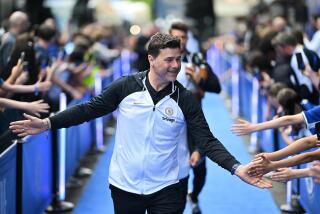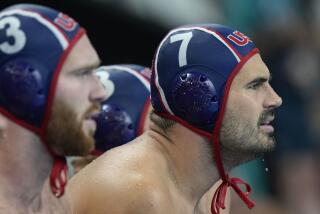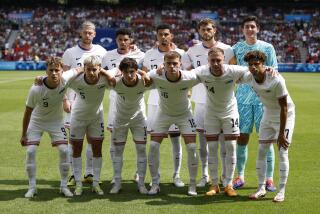U.S. menâs hockey team prepares to face Canada
Reporting from Vancouver, Canada â Their game.
In their barn, known during the Olympics as Canada Hockey Place, though almost any place in Canada is a hockey place.
Sundayâs preliminary-round finale between the U.S. and Canada has as many meanings as there are backyard rinks and ice-covered ponds on this side of the border. But at its heart is a pure and powerful competition between nations that have created a distinct style and exported it around the hockey world.
The U.S., with regulation victories over Switzerland and Norway, is in better shape to earn a bye into the quarterfinals than Canada, which routed Norway but needed two tries by Sidney Crosby to win a shootout against Switzerland. A loss Sunday by Canada would consign the nation that prides itself on having invented the game to a play-in contest. The play-in game figures to be a mismatch on paper, but the game isnât played on paper, eh?
Team USA General Manager Brian Burke wasnât exaggerating last week when he said, âThe pressure started building on Canada the day Vancouver got the bid.â
Team Canadaâs coach, Mike Babcock, acknowledged that he and his players must reconcile their game plan and the need for poise with the knowledge that they carry the hopes of millions on their padded shoulders.
âPressure -- if you donât break it up, you donât want it, you donât relish it -- is a great equalizer,â he said.
Sundayâs final round-robin games are rematches of the last three Olympic gold-medal games. First up is Russia against the Czech Republic, a repeat of the 1998 finale won by the Czechs. Canada faces the U.S. in a sequel to the gold-medal contest Canada won in Salt Lake City in 2002, and 2006 champion Sweden plays Turin runner-up Finland.
âIt might be one of the greatest hockey days, internationally, of all time,â said U.S. Coach Ron Wilson, who led the 1996 U.S. World Cup team to a victory over Canada in Montreal.
Hereâs how the Canadian and U.S. teams break down:
Goaltending
Babcock started Roberto Luongo in Canadaâs opener but came back with -- and will stay with -- Martin Brodeur, the three-time Stanley Cup champion, four-time Vezina Trophy winner, 2002 Olympic champion and the NHLâs career leader in wins, shutouts and games played. Thereâs a resume for you.
Ryan Miller of the Sabres, second in the NHL in goals-against average (2.16) and save percentage (.930) will start this and every game for the U.S., barring an injury. In two games he has stopped 24 of 26 shots, compiling a .923 save percentage and a 1.00 goals-against average.
Canada should have the edge because of Brodeurâs experience and big-game mentality.
Defense
Canadaâs defense has been erratic. The Blackhawksâ Brent Seabrook, chosen with defense partner Duncan Keith partly because of their familiarity with each other, sat for much of the third period against Switzerland. Scott Niedermayerâs struggles with the Ducks have carried over to the Olympics. Shea Weber, with a cannon of a shot, is averaging a team-high 23 minutes, 26 seconds of ice time per game and deserves it. Dan Boyle of San Jose has been strong, too, and 20-year-old Drew Doughty of the Kings hasnât looked out of place.
For the U.S., Ryan Suter of the Predators, smart and steady, is the ice-time leader at 20:18. Veteran Brian Rafalski of the Red Wings is second at 19:23, and heâs the only defenseman on either team who has a goal (he scored twice against Norway). Jack Johnson of the Kings has dished out bruising hits and is among seven players tied for the team plus/minus lead at plus-three. Ryan Whitney of the Ducks sat most of the third period against Switzerland and could be a weak link.
Canada should have a slight edge because of Chris Prongerâs meanness and Niedermayerâs agility.
Forwards
Canadaâs top line of Patrick Marleau, Joe Thornton and Dany Heatley has been outstanding, producing four goals and eight points.
Babcock hasnât found a regular right wing for Sidney Crosby and Rick Nash, replacing Jarome Iginla with a rotation of players. The line of Ryan Getzlaf centering for Corey Perry and Eric Staal, solid in the opener, was quieter against Switzerland.
Wilson broke up his No. 1 line of Zach Parise, Paul Stastny and Patrick Kane to put Jamie Langenbrunner in for Kane. He was considering using Kane with two-way standout Ryan Kesler and Ducks winger Bobby Ryan. David Backes of the Blues has been a force, using his size and strength and the truculence that Burke loves. Look for Backes on an âenergy lineâ with Kings winger Dustin Brown.
Phil Kessel, Ryan Malone (two goals in two games) and Joe Pavelski have been effective, with Kessel using his speed and Malone dangerous around the net.
Canada has more firepower but hasnât harnessed it. The U.S. has had trouble finding chemistry too. Both teams have the skill to go on a scoring spree at any time.
Canada is three-for-13 on the power play. The U.S. is two-for-eight but gave up a short-handed goal. Itâs too early to say much other than that Canada tends to pass too much with the man advantage and that Doughty should shoot more.
Borrowing a saying from the late U.S. coach Bob Johnson, Wilson predicted Sunday will be âa great day for hockey.â It also should be a day for great hockey.
More to Read
Go beyond the scoreboard
Get the latest on L.A.'s teams in the daily Sports Report newsletter.
You may occasionally receive promotional content from the Los Angeles Times.








